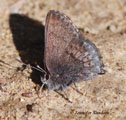Native Plants
Search for native plants by scientific name, common name or family. If you are not sure what you are looking for, try the Combination Search or our Recommended Species lists.
Epigaea repens
Epigaea repens L.
Trailing Arbutus, Mayflower, Plymouth Mayflower
Ericaceae (Heath Family)
Synonym(s): Epigaea repens var. glabrifolia
USDA Symbol: EPRE2
USDA Native Status: L48 (N), CAN (N), SPM (N)
Trailing-arbutus becomes a creeping mat, commonly only 4-6 in. high. The broad, oval, leathery leaves are aromatic and evergreen. A trailing, evergreen plant with sweet-scented pink or white flowers in terminal and axillary clusters on hairy stems. Trumpet-shaped, white to pale pink flowers, also aromatic, are followed by a whitish berry, resembling a raspberry in appearance.
For this favorite wildflower with an exquisite fragrance, one must search among the fallen leaves in early spring. It favors exposed sites where the plants are not smothered by leaf litter. In areas with heavy leaf litter, the plant can be located when flowering by sniffing for it on hands and knees. It appears to be sensitive to abrupt environmental disturbances, such as lumbering and grazing, which may account for its present scarcity. It is difficult to cultivate. Trailing Arbutus is sometimes referred to as "Plymouth Mayflower" in reference to the fact that it was the first flower to cheer the hearts of the Pilgrim Fathers after the rigors of their first New England winter.
Plant Characteristics
Duration: PerennialHabit: Shrub
Leaf Retention: Evergreen
Leaf Complexity: Simple
Fruit Type: Capsule
Size Notes: Stems prostrate or creeping, up to about 20 inches long.
Bloom Information
Bloom Color: White , PinkBloom Time: Feb , Mar , Apr , May , Jun , Jul
Distribution
USA: AL , CT , DC , DE , FL , GA , IL , IN , KY , MA , MD , ME , MI , MN , MS , NC , NH , NJ , NY , OH , PA , RI , SC , TN , VA , VT , WI , WVCanada: NB , NL , NS , ON , PE , QC
Native Distribution: ME & s.e. NY to OH, s. to FL & MS
Native Habitat: Sandy to peaty woods or clearings
Growing Conditions
Light Requirement: Part Shade , ShadeSoil Moisture: Moist
Soil pH: Acidic (pH<6.8)
Soil Description: Well-drained, humus-rich, acid soils.
Conditions Comments: Trailing arbutus is very difficult to establish and perpetuate. It will not tolerate disturbance, is extremely susceptible to failure during drought or flood, and is slow-growing even in good conditions. A mycorrhizal association may be necessary for survival.
Benefit
Conspicuous Flowers: yesFragrant Flowers: yes
Attracts: Butterflies
Larval Host: Hoary Elfin (Callophrys polia)
Butterflies and Moths of North America (BAMONA)
|
Hoary Elfin (Callophrys polios)  Larval Host |
Propagation
Seed Collection: The little green balls which replace the flowers, split in June to show brown seeds embedded in a white pulp. Collect quickly before birds and insect find them.Commercially Avail: yes
Mr. Smarty Plants says
Groundcover to reduce erosion for shady area in New York
May 05, 2009
We live on a lake with gravelly and clay soils, lots of wind and little sun. I am looking for a native ground cover that will help reduce erosion over some of the steep slopes facing south (under shad...
view the full question and answer
Evergreen shrubs for Michigan
June 17, 2008
I'm seeking a small-medium, ornamental, fairly compact, evergreen shrub to complement my front yard woodland wildflower garden. I want a shrub that will flank both sides of my front porch steps. I wa...
view the full question and answer
From the National Organizations Directory
According to the species list provided by Affiliate Organizations, this plant is on display at the following locations:Mt. Cuba Center - Hockessin, DE
Bibliography
Bibref 1186 - Field Guide to Moths of Eastern North America (2005) Covell, C.V., Jr.Bibref 1185 - Field Guide to Western Butterflies (Peterson Field Guides) (1999) Opler, P.A. and A.B. Wright
Search More Titles in Bibliography
Web Reference
Webref 38 - Flora of North America (2019) Missouri Botanical Garden, St. Louis, MO & Harvard University Herbaria, Cambridge, MA.Webref 23 - Southwest Environmental Information Network (2009) SEINet - Arizona Chapter
From the Archive
Wildflower Newsletter 1992 VOL. 9, NO.1 - Research Update, Creating Native Lawn with Sod, Director's Report, What Makes Pl...Additional resources
USDA: Find Epigaea repens in USDA PlantsFNA: Find Epigaea repens in the Flora of North America (if available)
Google: Search Google for Epigaea repens
Metadata
Record Modified: 2023-04-14Research By: TWC Staff